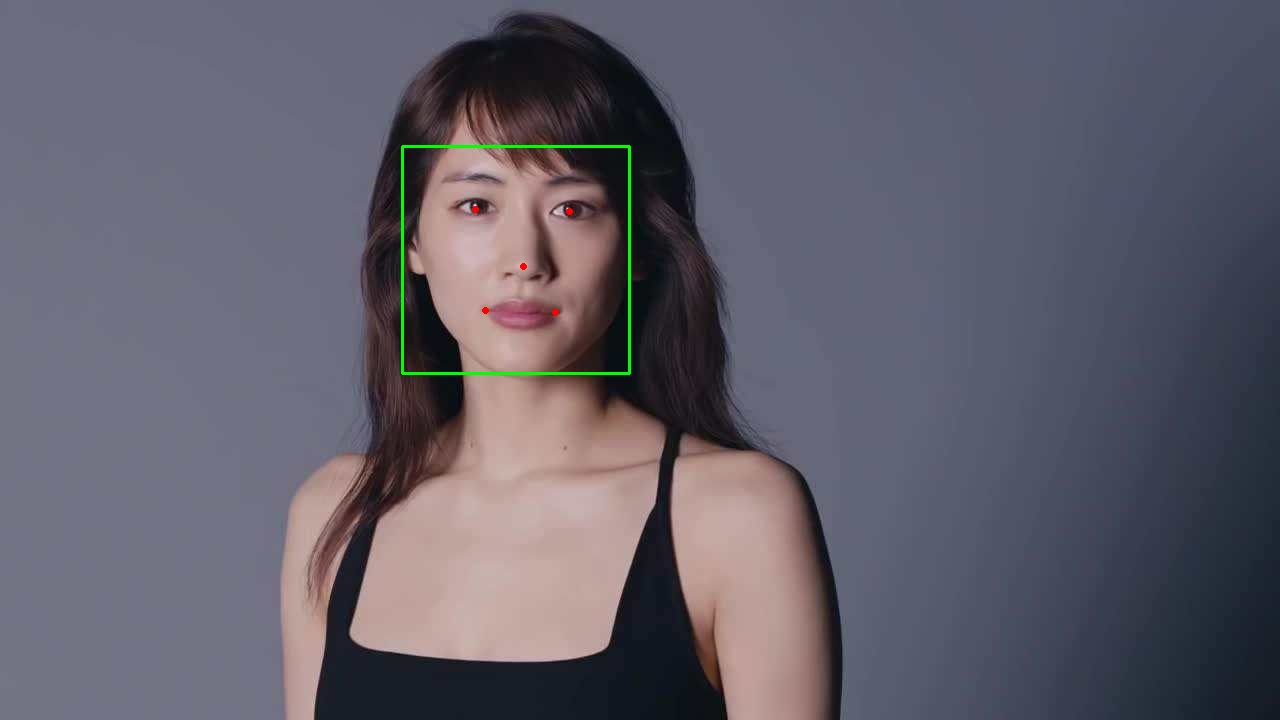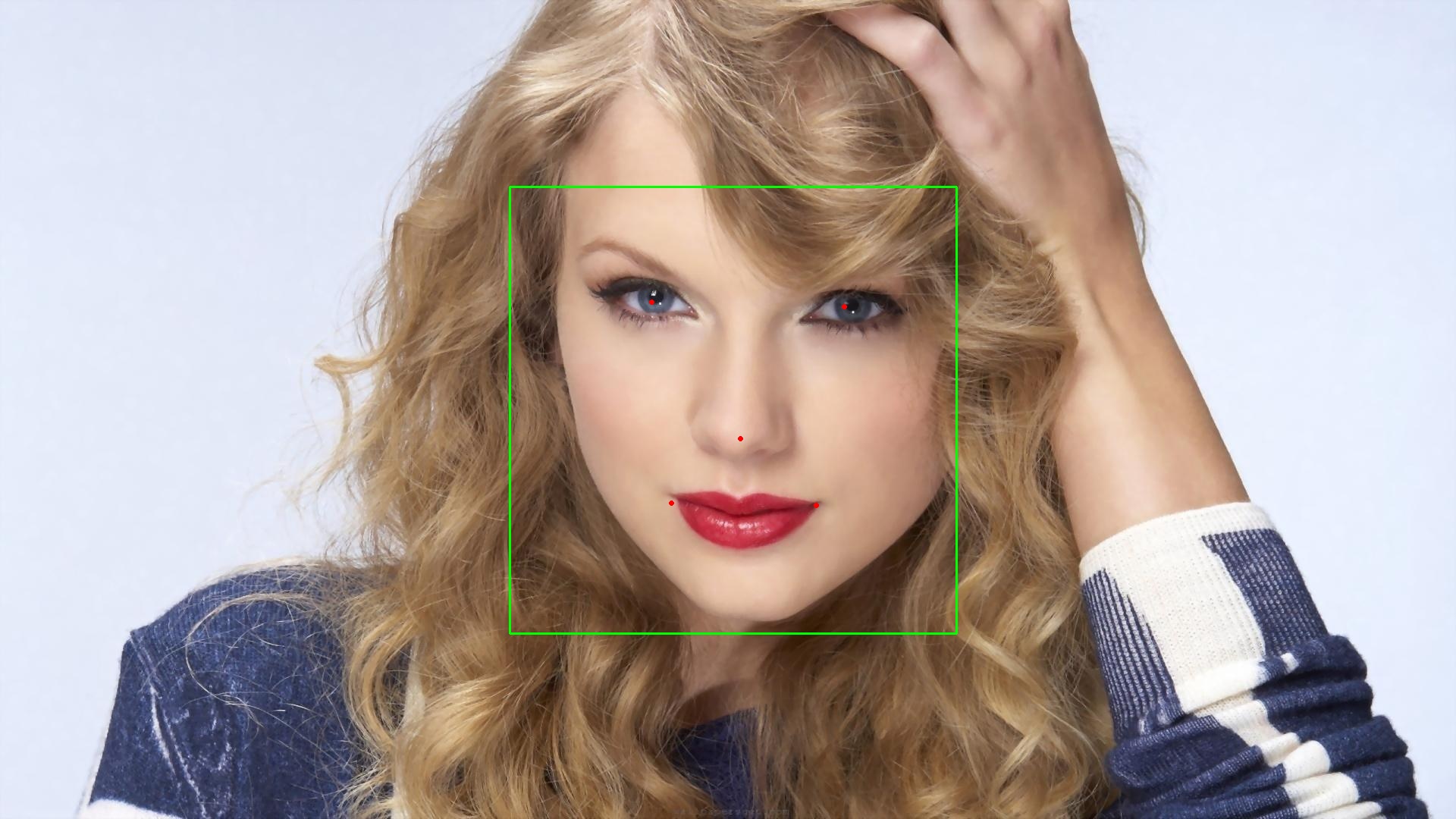Face Detect V1.0(TrialFaceSDK)
Capability Introduction
Interface Capability
- Face Detect: Detect face in images, and calculate possibility, angle, position of key points(eyes, nose, mouse)
Dependencies
- CPU: MSVCP140、VCRUNTIME140
Invoke Method
Example Code 1st
1
2
3
4
5
6
7
8
9
10
11
12
13
14
15
16
17
18
19
20
21
22
23
24
using namespace glasssix;
using namespace glasssix::longinus;
int main()
{
//do not support GPU in TrialFaceSDK
int device = -1;//using CPU when device is less than zero, otherwise use the GPU numbered by 'device', device is set to -1 by default.
LonginusDetector detector;
detector.set(FRONTALVIEW, device);
cv::Mat img = cv::imread("../TestImage/2.png");
cv::Mat gray;
cv::cvtColor(img, gray, CV_BGR2GRAY);
std::vector<FaceRect> rects = detector.detect(gray.data, gray.cols, gray.rows, gray.step[0], 24, 1.1f, 3, false, false);
for (int i = 0; i < rects.size(); i++)
cv::rectangle(img, cv::Rect(rects[i].x, rects[i].y, rects[i].width, rects[i].height), cv::Scalar(0, 255, 0));
cv::imshow("hehe", img);
cv::waitKey(0);
return 0;
}Class Description: RomanciaDetector
Member Function
Capability: set detect method and devicevoid set(DetectionType detectionType, int device);
| Parameter | Parameter Type | Value | Illustration | Remark |
|---|---|---|---|---|
| detectionType | enum DetectionType | FRONTALVIEW FRONTALVIEW_REINFORCE MULTIVIEW MULTIVIEW_REINFORCE |
detect effect and time consuming both ascend | |
| device | int | <0>=0 |
use cpu use gpu numberd by ‘device’ |
Member Functionvoid load(std::vector<std::string> cascades, int device = -1);
Capability: load classifier model
| Parameter | Parameter Type | Value | Illustration | Remark |
|---|---|---|---|---|
| cascades | std::vector<std::string> |
user input | each element in vector represents a model file | model file in xml format |
| device | int | <0>=0 |
use cpu use gpu numberd by ‘device’ |
Member Functionstd::vector<FaceRect> detect(unsigned char *gray, int width, int height, int step, int minSize, float scale, int min_neighbors, bool useMultiThreads = false, bool doEarlyReject = false);
Capability: detect and locate face in single-channel image
| Parameter | Parameter Type | Value | Illustration | Remark |
|---|---|---|---|---|
| gray | unsigned char * |
user input | address of single-channel image data | image data should store continuously |
| width | int | user input | width of single-channel image | |
| height | int | user input | height of single-channel image | |
| step | int | user input | bytes of each row in single-channel image | |
| minSize | int | effect value>=24 |
smallest detect window size | detected face area>=minSize |
| scale | float | >1 |
expand or shrink ratio of image | >1.1 |
| min_neighbors | int | >=0 |
candidate boxes around face area | 3 by default |
| useMultiThreads | bool | true false |
use multi-thread use single-thread |
take effect when using cpu, false by default |
| doEarlyReject | bool | true false |
adopt early reject don’t adopt |
detect speed promote, with detect effect descend, false by default |
- Return Value
std::vector<FaceRect>, FaceRect contains detected face area information
Struct Description: FaceRect
| Member Variable | Type | Illustration | Remark |
|---|---|---|---|
| x | int | x coordinate of left-top corner | |
| y | int | y coordinate of left-top corner | |
| width | int | width of face area | |
| height | int | height of face area | |
| neighbors | int | number of candidate boxes around face area | |
| confidence | double | possibility to be a face |
Example Code 2nd:
1 |
|
Member Functionstd::vector<FaceRectwithFaceInfo> detect(unsigned char *gray, int width, int height, int step, int minSize, float scale, int min_neighbors, int order = 0, bool useMultiThreads = false, bool doEarlyReject = false);
Capability: detect and locate face in single-channel image
| Parameter | Parameter Type | Value | Illustration | Remark |
|---|---|---|---|---|
| gray | unsigned char * |
user input | address of single-channel image data | image data should store continuously |
| width | int | user input | width of single-channel image | |
| height | int | user input | height of single-channel image | |
| step | int | user input | bytes of each row in single-channel image | |
| minSize | int | effect value>=24 |
smallest detect window size | detected face area>=minSize |
| scale | float | >1 |
expand or shrink ratio of image | >1.1 |
| min_neighbors | int | >=0 |
candidate boxes around face area | 3 by default |
| order | int | array of face image data:NCHW/NHWC | order=0(NCHW),otherwise(NHWC) | |
| useMultiThreads | bool | true false |
use multi-thread use single-thread |
take effect when using cpu, false by default |
| doErlyReject | bool | true false |
adopt early reject don’t adopt |
detect speed promote, with detect effect descend, false by default |
- Return Value
std::vector<FaceRectwithFaceInfo>Type, FaceRectwithFaceInfo contains information: detected face area, key points, possibility
Member Functionvoid extract_faceinfo(std::vector<FaceRectwithFaceInfo> face_info, std::vector<std::vector<int>>& bboxes, std::vector<std::vector<int>>& landmarks);
Capability: extract face area to save in bboxes, and extract key points to save in landmarks
| Parameter | Parameter Type | Value | Illustration | Remark |
|---|---|---|---|---|
| face_info | std::vector<FaceRectwithFaceInfo> |
detected face information | ||
| bboxes | std::vector<std::vector<int>> |
bboxes.size(): number of faces detected, bboxes[i][0]:x,bboxes[i][1]:y,bboxes[i][2]:width,bboxes[i][3]:height | ||
| landmarks | std::vector<std::vector<int>> |
landmarks.size():number of faces detected, landmarks[i][0]:x_lefteye,landmarks[i][1]:y_lefteye,landmarks[i][2]:x_righteye,landmarks[i][3]:y_righteye,landmarks[i][4]:x_nose,landmarks[i][5]:y_nose,landmarks[i][6]:x_leftmouse,landmarks[i][7]:y_leftnouse,landmarks[i][8]:x_rightmouth,landmarks[i][9]:y_rightmouth |
Member Functionvoid extract_biggest_faceinfo(std::vector<FaceRectwithFaceInfo> face_info, std::vector<std::vector<int>>& bboxes, std::vector<std::vector<int>>& landmarks);
Capability: extract biggest face area to save in bboxes, and extract key points of biggest face area to save in landmarks
| Parameter | Parameter Type | Value | Illustration | Remark |
|---|---|---|---|---|
| face_info | std::vector<FaceRectwithFaceInfo> |
detected face information | ||
| bboxes | std::vector<std::vector |
bboxes.size(): number of faces detected, bboxes[i][0]:x,bboxes[i][1]:y,bboxes[i][2]:width,bboxes[i][3]:height | ||
| landmarks | std::vector<std::vector |
landmarks.size():number of faces detected, landmarks[i][0]:x_lefteye,landmarks[i][1]:y_lefteye,landmarks[i][2]:x_righteye,landmarks[i][3]:y_righteye,landmarks[i][4]:x_nose,landmarks[i][5]:y_nose,landmarks[i][6]:x_leftmouse,landmarks[i][7]:y_leftnouse,landmarks[i][8]:x_rightmouth,landmarks[i][9]:y_rightmouth |
Member Functionstd::vector<unsigned char> alignFace(const unsigned char* ori_image, int n, int channels, int height, int width, std::vector<std::vector<int>> bbox, std::vector<std::vector<int> >landmarks);
Capability: Align Face
| Parameter | Parameter Type | Value | Illustration | Remark |
|---|---|---|---|---|
| ori_image | const unsigned char* |
single-channel image used for detect face area | ||
| n | int |
number of single-channel image | ||
| channels | int |
channel of single-channel image | ||
| height | int |
height of single-channel image | ||
| width | int |
width of single-channel image | ||
| bbox | std::vector<std::vector<int>> |
bboxes.size(): number of faces detected, bboxes[i][0]:x,bboxes[i][1]:y,bboxes[i][2]:width,bboxes[i][3]:height | ||
| landmarks | std::vector<std::vector<int>> |
landmarks.size():number of faces detected, landmarks[i][0]:x_lefteye,landmarks[i][1]:y_lefteye,landmarks[i][2]:x_righteye,landmarks[i][3]:y_righteye,landmarks[i][4]:x_nose,landmarks[i][5]:y_nose,landmarks[i][6]:x_leftmouse,landmarks[i][7]:y_leftnouse,landmarks[i][8]:x_rightmouth,landmarks[i][9]:y_rightmouth |
- Return Value
std::vector<unsigned char>, alignedFace data stored in vector
Face Match
Capability Introduction
Interface Capability
- Face Match: input detect result of consecutive video frame, then judge whether faces belong to a same person. Take effect when camera position is fixed.
Invoke Method
Example Code 3rd:
1
2
3
4
5
6
7
8
9
10
11
12
13
14
15
16
17
18
19
20
21
22
23
24
25
26
27
28
29
30
31
32
33
34
35
36
37
38
39
40
41
42
43
44
45
46
47
48
49
50
51
52
53
54
55
56
57
58
using namespace glasssix;
using namespace glasssix::longinus;
int main(int argc, char** argv)
{
cv::Mat frame;
cv::Mat gray;
int frame_extract_frequency = 5; // frequency of extracting one frame
cv::VideoCapture capture("..\\data\\group.mp4");
if (!capture.isOpened())
{
std::cout << "Reading Video Failed !" << std::endl;
getchar();
return 0;
}
int frame_num = capture.get(cv::CAP_PROP_FRAME_COUNT);
int device = -1;
LonginusDetector detector;
detector.set(MULTIVIEW_REINFORCE, device);
// loop through every frame in the video
for (int i = 0; i < frame_num - 1; i++)
{
capture >> frame;
cv::cvtColor(frame, gray, cv::COLOR_RGB2GRAY);
if (i % frame_extract_frequency == 0)
{
// retrieve a number of rects, it calls detector.detect(), which returns frontal face detections.
std::vector<FaceRect> rects = detector.detect(gray.data, gray.cols, gray.rows, gray.step[0], 24, 1.1f, 3, false, false);
auto results = detector.match(rects, frame_extract_frequency);// you can also use std::vector<FaceRectwithFaceInfo>, modify detector.detect()
// show the face rects and string id on every frame
for (size_t j = 0; j < results.size(); j++) {
cv::Rect temp_(results[j].rect.x, results[j].rect.y, results[j].rect.width, results[j].rect.height);
cv::rectangle(frame, temp_, cv::Scalar(0, 0, 255));
cv::putText(frame, results[j].id, temp_.tl(), cv::FONT_HERSHEY_SIMPLEX, 0.5, cv::Scalar(255, 255, 255), 1, CV_AA);
} // end-for-j
//matcher_.print_map();
} // end-if-mod-frequency
// display 1 frame every num frames
if (i % frame_extract_frequency == 0) {
cv::imshow("test", frame);
cv::waitKey(5);
}
} // end-for-i
return 0;
}Class Description: Matcher
Member Function
Capability: set an uuid for each input face area, judge whether it’s new in video frames.std::vector<Match_Retval> match(std::vector<FaceRect> &faceRect, const int frame_extract_frequency);
| Parameter | Parameter Type | Value | Illustration | Remark |
|---|---|---|---|---|
| faceRect | std::vector<FaceRect> |
– | get by function LonginusDetector.detect() | |
| frame_extract_frequency | int | positive integer | interval between two frames to be dealt with |
- Return Value
std::vector<Match_Retval>Type, Match_Retval contains detected face area information and uuid
Member Functionstd::vector<Match_Retval> match(std::vector<FaceRectwithFaceInfo> &faceRect, const int frame_extract_frequency);
Capability: set an uuid for each input face area, judge whether it’s new in video frames.
| Parameter | Parameter Type | Value | Illustration | Remark |
|---|---|---|---|---|
| faceRect | std::vector<FaceRectwithFaceInfo> |
– | get by function LonginusDetector.detect() | |
| frame_extract_frequency | int | positive integer | interval between two frames to be dealt with |
- Return Value
std::vector<Match_Retval>Type, Match_Retval contains detected face area information and uuid
Struct Description: Match_Retval
| Member Variable | Type | Illustration | Remark |
|---|---|---|---|
| rect | FaceRect | face area | |
| id | std::string | 32bit uuid | |
| is_new | bool | flag to judge whether this face area belongs to a new person |
Example Code 4th:
1 |
|
Longinus Performance
Test three face images(size: 640 * 480,1280 * 720,1920 * 1080) on platform i7-8700K: loop 1000 times and calculate average detect time.
Basic Information of Test Platform
| Item | Description |
|---|---|
| Operating System | Windows 10 Enterprise 64bit |
| Processor | Intel(R) Core(TM) i7-8700K CPU @ 3.70GHz |
| Core and Thread | 6 Cores and 12 Threads |
| RAM | 32GB |
| Compiler | MSVC 19.5 |
| OpenMP | Yes |
| SIMD Instruction Set | AVX2 |
Test Report
Parameter: minSize=48, scale=1.2, minNeighbors=3, useMultiThreads=false, doEarlyReject=false
Detect Time(ms):
| Image_Size | FRONTALVIEW | FRONTALVIEW_REINFORCE | MULTIVIEW | MULTIVIEW_REINFORCE |
|---|---|---|---|---|
| 640 * 480 | 11.72 | 25.72 | 34.06 | 41.42 |
| 1280 * 720 | 26.14 | 45.44 | 69.09 | 85.07 |
| 1920 * 1080 | 76.59 | 122.38 | 155.89 | 186.86 |



Declaration: Test face images come from Internet, all rights belong to original Author. If we infringed your legal rights, please contact us to erase images. Thanks!